
Is B2B2C the Same as an Ecommerce Marketplace?
If you’re deeply involved in the ecommerce industry, you may be familiar with B2C, B2B and B2B2C ecommerce models. These terms can seem confusing for those relatively new to this industry. But they’re all simpler than you may think. The pressing question is how do ecommerce marketplaces fit into these models? In ecommerce marketplaces such as Amazon and eBay, retailers offer their own products to customers, while the marketplace platforms handle product merchandising, marketing, and fulfilment. Thus, we can say that marketplace platforms, Amazon and eBay, and their retailers function in the B2B2C ecommerce model.
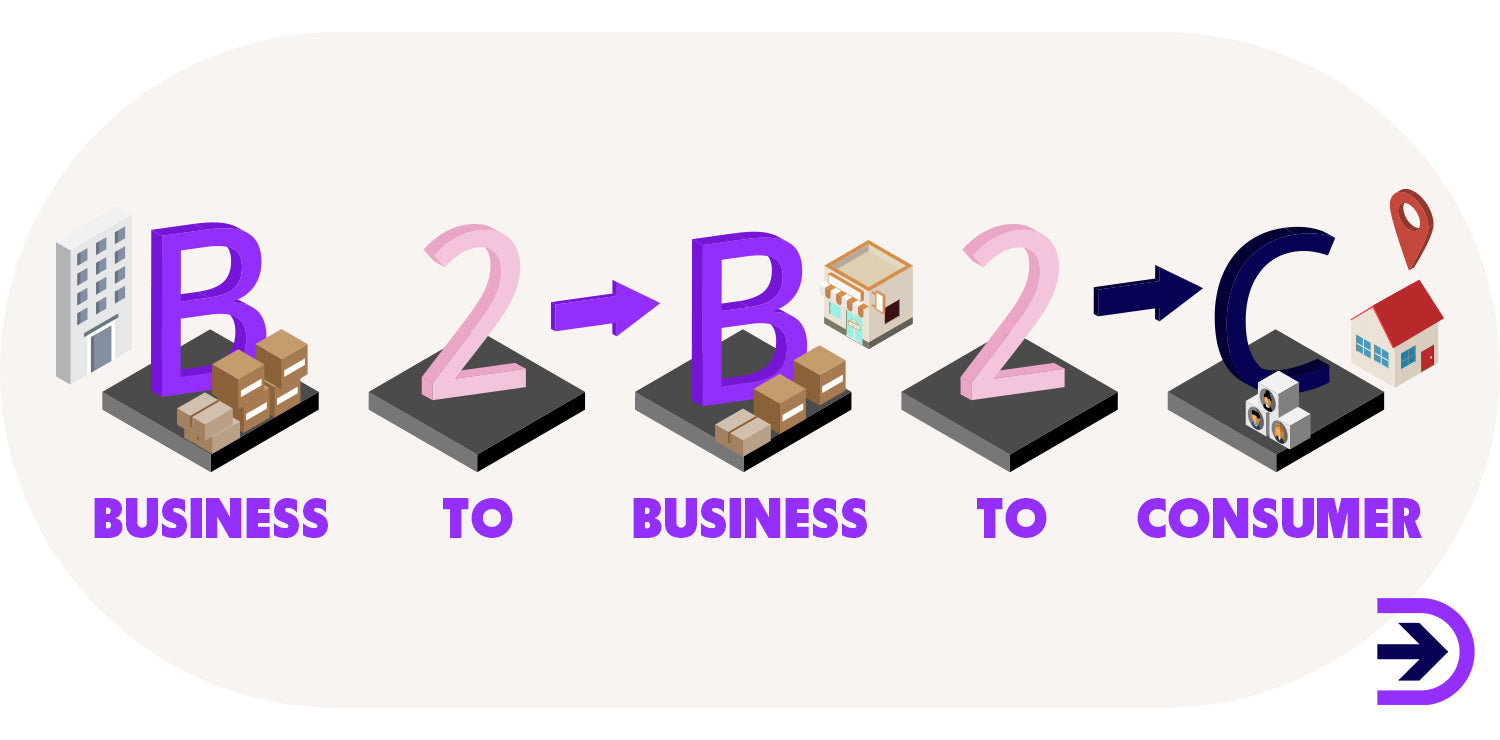
Each ecommerce business model has its benefits and challenges. So, which ecommerce model is ideal for your business? The experts at Dropshipzone, one of Australia’s B2B2C marketplaces, are here to show you the key differences between these models and help you to choose the right model for your business.
What is the B2B2C Business Model?
B2C (Business-to-Customer) and B2B (Business-to-Business) are traditional ecommerce models. The recent growth of ecommerce has resulted in the rise of the B2B2C (Business-to-Business-to-Consumer) ecommerce business model. This business model has been gaining popularity with more businesses expanding to a B2B2C model.
The B2C business model is where a retailer sells goods or services to an end consumer. Grocery stores, hairdressers and homeware stores are great examples of B2C ecommerce models. Most of these businesses will work with a supplier for their products, but some are Direct-to-Consumer (D2C), meaning the manufacturer or supplier will sell directly to the consumer instead of going through a retailer.
In the B2B business model, suppliers, manufacturers or wholesalers supply goods and services to retailers and distributors. These businesses do not sell directly to consumers but partner with other companies for doing business. For example, a wholesaler sells products to retailers at a reduced price. Other examples include industrial software manufacturers, hardware manufacturers, and raw material suppliers.
The B2B2C ecommerce business model combines these two traditional business models into a single entity. These businesses sell products or services to individual consumers through an intermediary. This intermediary can be an online retailer, a social media platform, or a marketplace. According to the Customer Experience and Engagement in Manufacturing survey report 2022, the B2B2C ecommerce model is rising in popularity among organisations looking to deliver a great customer experience. The opinions are divided, with 39.22% of manufacturers looking to adopt the B2B2C model and 35.29% ruling out the possibility of investing in it. But the remaining 25.49% of survey participants have pivoted successfully to a B2B2C model.

The B2B2C model is a win-win for all parties. It offers more business opportunities compared to other business models as it can improve product marketability, scale appropriately with business growth, and foster positive business relationships. Customers also enjoy this model because they get access to a wide range of products.
Popular examples of B2B2C ecommerce
Uber
Uber is one of the most prolific examples of the B2B2C business model. When you order a rideshare, the driver (supplier) partners with the app to find passengers (buyers) to sell a service. When you order from Ubereats, the restaurant is the supplier, while the app covers delivery services by providing a delivery driver (who is another supplier) to buyers.
Affirm
Another example of the B2B2C model is Affirm, a B2B2C financial service provider offering financing options to businesses. In order to offer “buy now, pay later” services, various companies have partnered with Affirm, including Casper and Shopify. This business partnership has made it easier for customers to make purchases from Shopify and Casper stores using their preferred payment method, which increased sales. It also helped Affirm increase its customer base by offering financial solutions to Shopify's existing customer base.
Shopify app store
Shopify, an ecommerce company, is also an example of a B2B2C business model. It helps businesses build an impressive ecommerce website, while their app store connects developers with businesses requiring their services. Thanks to these app developers, Shopify stores can utilise Shopify integrations with other services such as Printful, TikTok, Pinterest, Shopify Translate & Adapt, and Dropshipzone (through the Sofortig app), which can help Shopify store owners streamline operations, enhance customer experiences, and promote business growth.
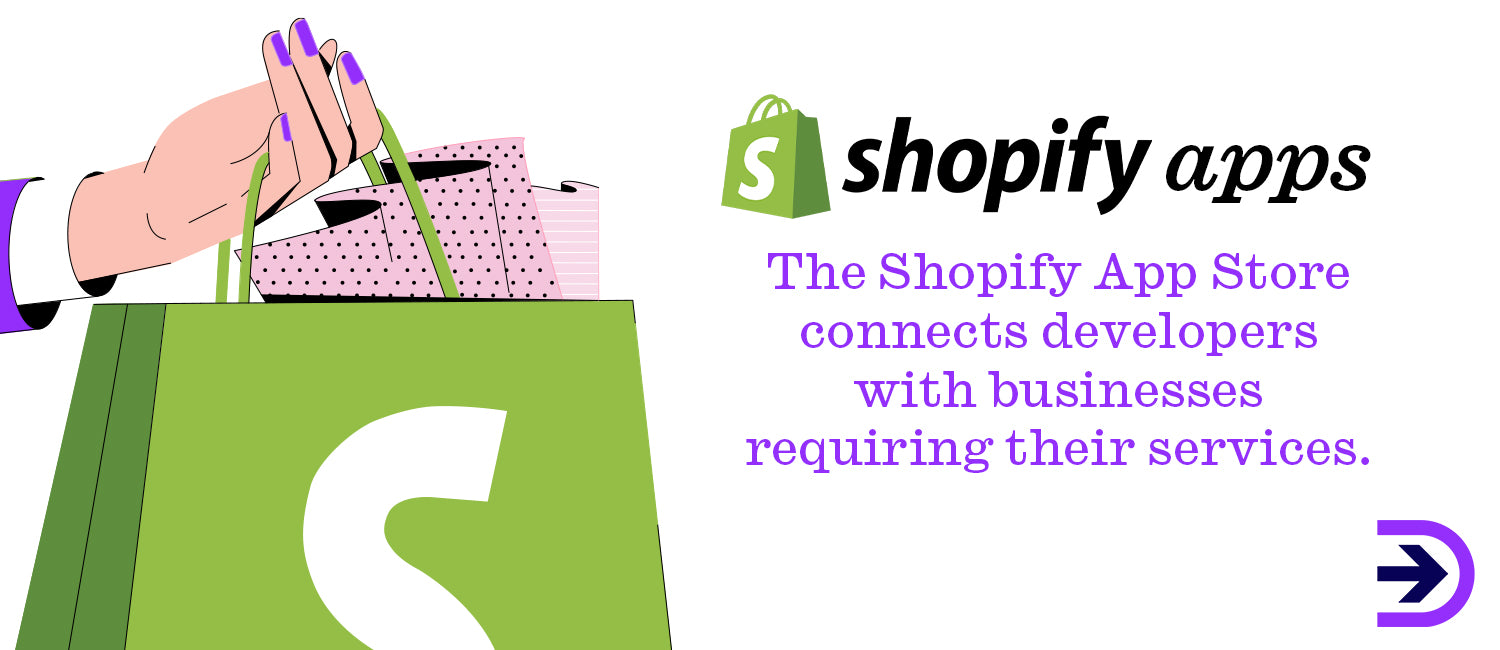
What is the Marketplace Model of Ecommerce?
An ecommerce marketplace connects sellers and buyers on a single, centralised platform where sellers can sell their products and connect with potential customers. The ecommerce marketplace facilitates transactions between parties and may offer additional financial or fulfilment services. While some marketplaces may offer their own stock, such as Amazon, a marketplace doesn’t usually manage inventory or products. Instead, their profit comes from fees or commissions from their users. There are two categories: horizontal marketplaces, which sell products across different categories but have a similar level of service, and vertical marketplaces, which focus on a single product category but offer a variety of services within that category.
To understand how an ecommerce marketplace works, think of your local farmer’s market. Without sellers, the market is simply a block of land waiting to be filled. Stall holders will register with the organisers and pay a fee to host their stall. The organisers will be in charge of promoting the market and may highlight individual sellers. Some markets assist sellers by offering a payment service. At the end of the market, sellers walk away with any remaining inventory. This process is very similar to how an ecommerce marketplace works.
There are several different ecommerce marketplace models that offer different benefits and profit margins. Most marketplaces will use a combination of models to maximise profit without compromising service.
Commission model
A marketplace platform charges a commission on each successful transaction. It may charge either a buyer or a seller. A key benefit of this model is that buyers and sellers can join the platform for free. They only need to pay when they make a sale or a purchase. Uber and other delivery services such as DoorDash earn money through commissions and additional fees.
Subscription model
In the subscription model, a marketplace platform charges a recurring subscription fee to access the marketplace. It gives sellers and buyers access to premium services and high-quality products or services, but the platform needs to demonstrate value to be successful. Skillshare offers a platform for teachers and learners to connect through a wide variety of courses, and their main revenue stream comes from Skillshare Premium or Skillshare Teams subscription fees. There is no free version of Skillshare, meaning every current user is paying monthly or annually for access to courses.
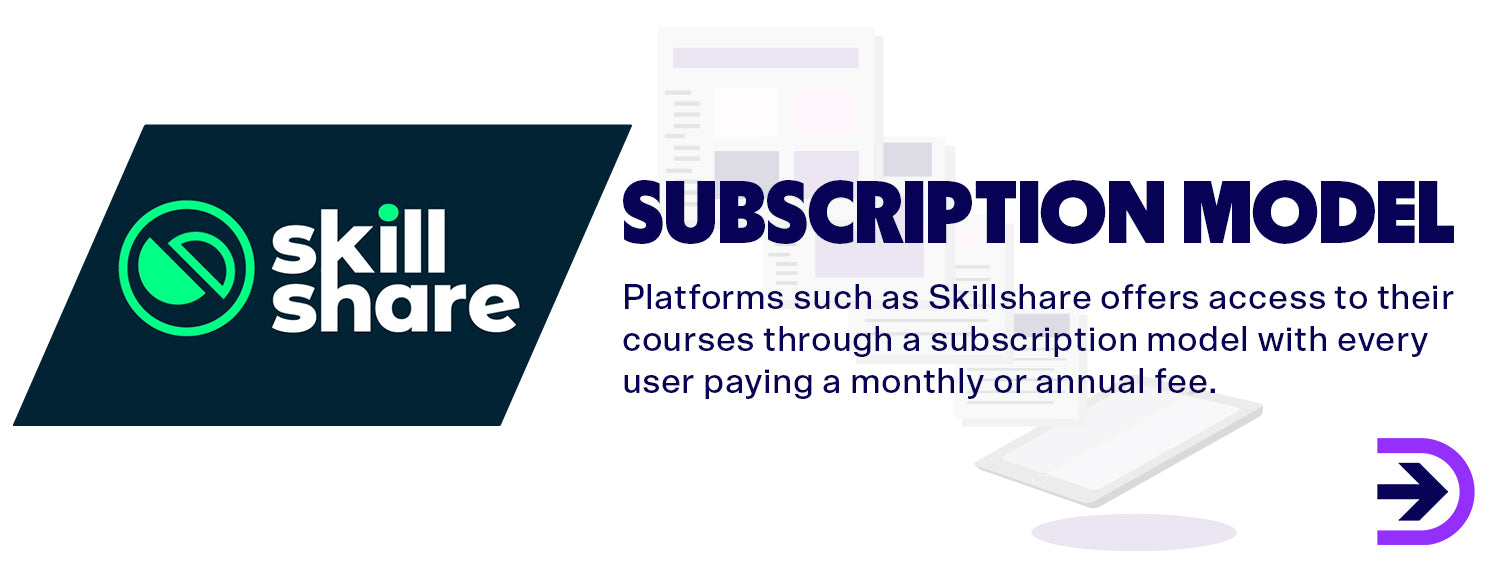
Freemium model
In the freemium model, a platform is free for sellers and buyers to join, but they have to pay to access premium features and services. This model allows marketplaces to demonstrate what they can offer and tempt consumers to stay and use the site, so, at some point, they willingly pay for locked content. Zoom is free to sign up and use, but meetings are limited to 40 minutes and 100 attendees. For longer meetings, businesses and individuals can purchase the plans that increase the meeting time and add other features such as Cloud storage.
Listing model
A marketplace platform charges sellers for every listing they add to the marketplace. This model is best for big-ticket items but only works if the site attracts a lot of traffic. Sellers are willing to pay to make their products seen and will stay away from a platform that won’t deliver results. Handmade platform Etsy charges a $0.20 USD listing fee per item, and most listings expire after 4 months.
Featured ads
In a marketplace platform, sellers can pay additional fees to display their listings first. Featured ads is often combined with other models. Amazon and eBay are two sites that offer sponsored ads to get certain listings to the top of a search query.
Popular Examples of Ecommerce Marketplaces
Dropshipzone
Dropshipzone is Australia’s leading B2B2C marketplace. Launched in 2012, the ecommerce platform was founded by New Aim and introduced the dropshipping model to Australia. Suppliers and retailers can sign up for free and get instant access to a wide range of product categories and buyers around Australia. The platform connects reliable suppliers with eager buyers and offers attractive benefits like promotions, competitive prices and leading market courier rates. It also provides data integration capabilities with Shopify stores using their in-house app, Sofortig. Dropshipzone is free to join and works on a commission model.
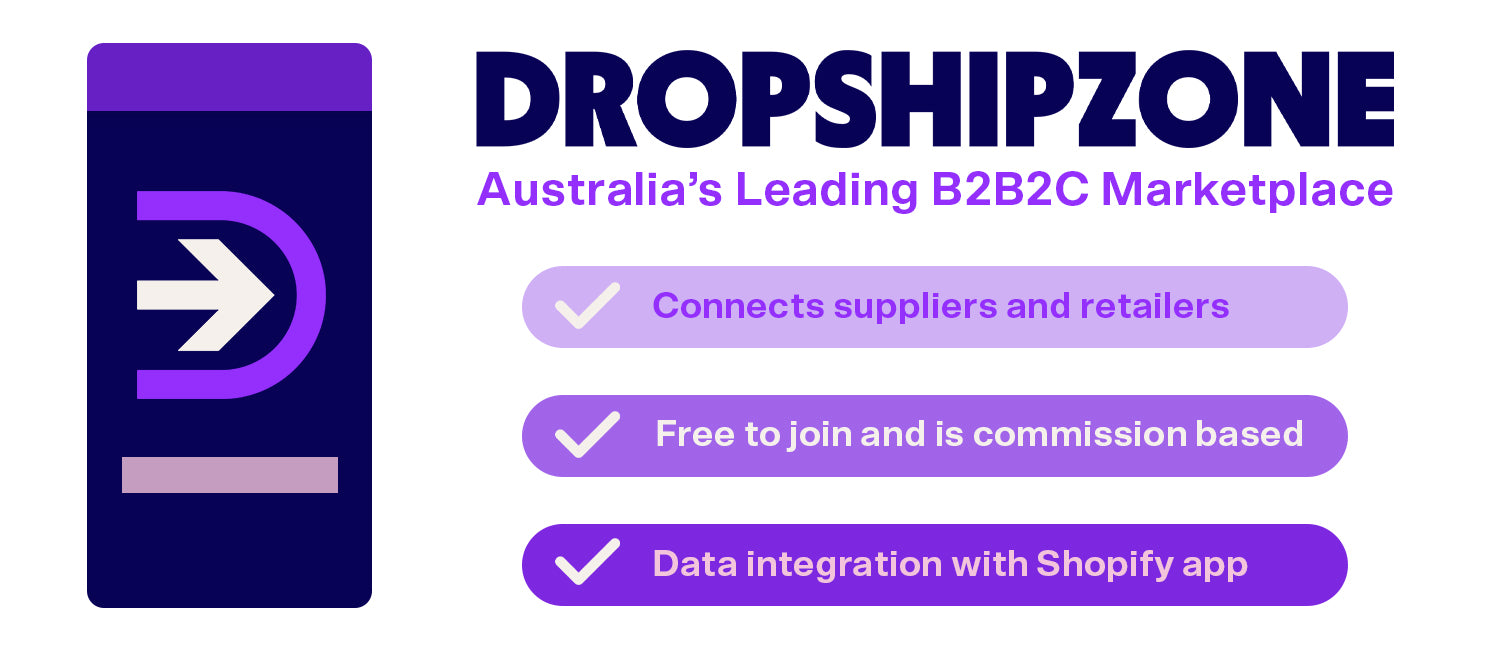
Dropshipzone provides a unique opportunity for entrepreneurs to get their dropshipping business off the ground quickly and easily. By sourcing quality suppliers, retailers can avoid months of supplier and product research. Suppliers benefit from exposing their brand to thousands of retailers at once, saving time and effort in marketing. Both parties benefit from increased profit margins through promotions, competitive rates, and outsourced fulfilment.
Amazon
Amazon is a multinational technology company that provides a wide range of services, including the wildly successful Amazon ecommerce marketplace. Founded in 1994, it initially sold only books, music and videos, and expanded its product categories in 1999. It quickly grew and became one of the most popular online marketplaces in the world, with 45% share of the US ecommerce market in 2019 and a brand value of $705.65 billion USD in 2022. Amazon uses a subscription model alongside featured ads, premium features and other fees.
As a large, well-known and trusted platform, Amazon offers suppliers and retailers a level of prestige as well as excellent customer service. There are many ways to sell on Amazon, including Fulfilment By Amazon (FBA), dropshipping and Kindle Direct Publishing (KDP). Amazon also offers premium services for buyers, such as Amazon Prime. Despite a higher price tag than other markets, Amazon is incredibly flexible and suitable for many business types at any growth stage.
eBay
eBay is a multinational ecommerce company founded in 1995. It was designed to facilitate C2C and B2C auctions but has expanded to include “Buy it Now” shopping, shopping by SKU, and other features. eBay works on a commission model, with sellers paying a final value fee for sold items. Sellers can also pay to use the company’s listing upgrade features, and some fees may apply based on selling activity, dispute resolution, international sales, currency conversion and GST. Sellers can also pay for ads on a cost-per-click basis.
Like Amazon, eBay offers brand recognition, exposure for sellers and an easy-to-use platform to sell online. The eBay Plus subscription allows buyers to access free shipping in metro areas, exclusive deals year-round, and free returns for peace of mind. The platform also offers fulfilment services through Orange Connex.
Airbnb
Airbnb is an online marketplace platform for short and long-term accommodation. The company is known for its C2C operations, with individuals opening their homes to vacationers throughout the holiday season. However, Airbnb also connects individuals and businesses through rental properties and unique accommodation offers.
Airbnb uses a hybrid model, adding service fees to the price set by hosts and taking a percentage commission for each stay. Unlike other marketplaces, users can switch between being hosts (sellers) and travellers (buyers). It allows sellers to vary prices depending on seasonality and offer a volume discount. There is also very little competition, with Airbnb dominating the tourism market. Taking advantage of their popularity, businesses can reach audiences and raise profit margins.
Key Difference Between Online Marketplaces & B2B2C Businesses
Marketplaces often provide services to retailers such as merchandising, fulfilment and marketing. While most marketplaces fall under a model, they aren’t inherently B2B2C.
In B2B2C, the end consumer knows they’re buying from a retailer, not the platform. For example, when you buy a pair of shoes from Company A on Amazon, you will expect a product from Company A. However, suppliers can also engage in channel partnerships where a business sells products to a distributor or reseller who can use their own private labelling. For example, if you buy a pair of gloves from Company B, they may have an agreement with Company A that they’ll buy them under a private label so that the gloves will arrive with a Company B logo, and you won’t know the gloves are made by Company A. In this way, parts of the supply chain are obscured.
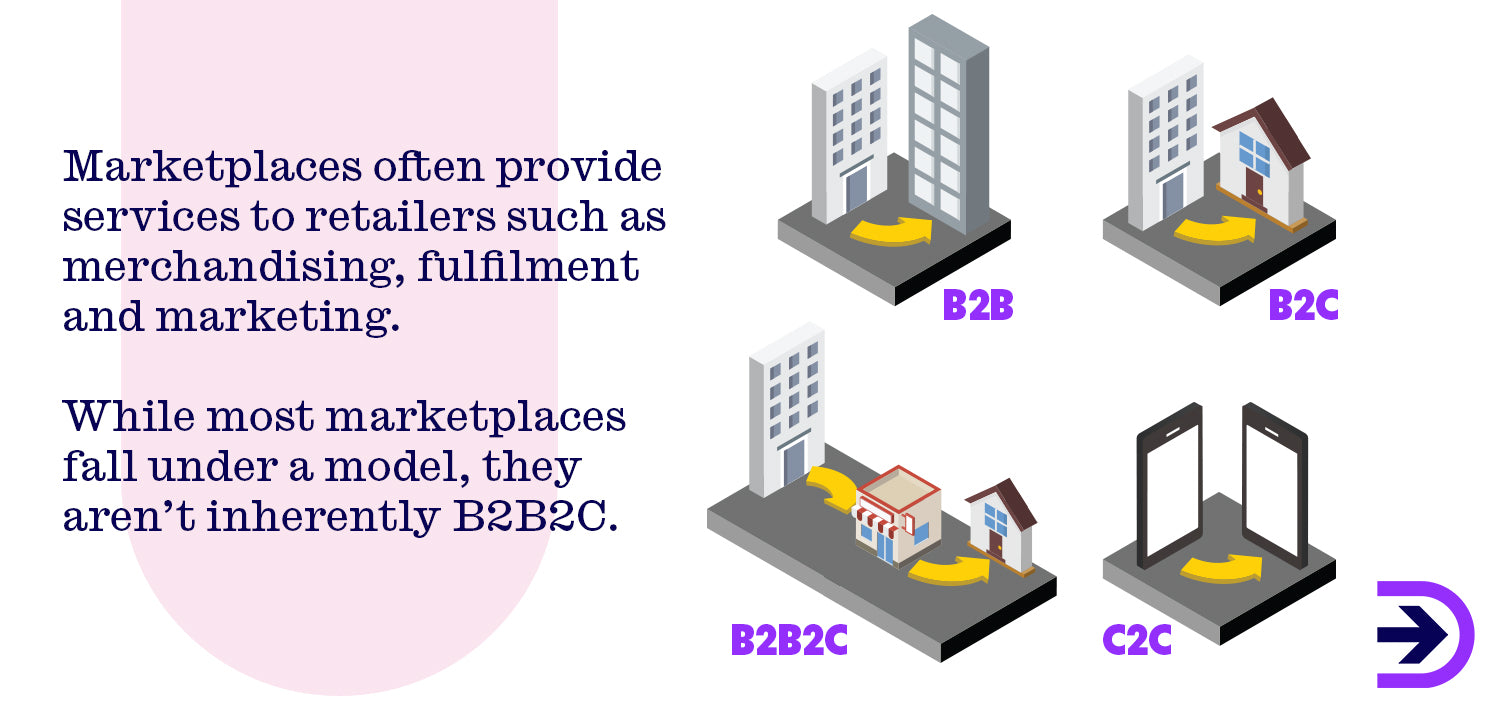
When marketing your B2B2C company, you’ll be targeting two separate entities. You’ll need to convince manufacturers and suppliers to use your platform and explain to retailers why your supplier’s products are superior. This can make marketing strategies and customer acquisition a timely and expensive process. You need to find the right balance in order to serve both sides. Marketing teams may benefit from outlining a B2B2C customer journey map as it may help them understand the different needs of each party and find data to assist in consumer research.
In addition, a B2B2C model isn’t just about selling to suppliers and end consumers. B2B2C is a partnership between two distinct businesses. The products and services of one company work with the other to enhance the end consumer's experience. If your company sells to both B2C and B2B customers, but you cover every aspect of the business, that’s not B2B2C. For example, a handmade card seller might sell directly to consumers via their ecommerce website and also sell to local gift stores, but it would not be considered B2B2C.
Finally, B2B2C is a complex process that requires knowledge of the digital landscape and how to use it for marketing purposes, also known as digital maturity. If you’re simply a retailer selling on a marketplace, you can lean on their services to help market your business with less effort.
Can a marketplace fit within the B2B2C model?
Yes. Online marketplaces suit the B2B2C ecommerce model. Unlike traditional sales channels that serve either B2B or B2C, these business models can benefit all parties end to end, from manufacturers to consumers. Many online marketplaces start as B2C platforms as a way to onboard sellers or customers and develop a loyal customer base before transitioning to a B2B2C model that leverages this customer base to new sellers. This presents new opportunities for the business to scale and offset certain logistics.
Benefits of converting to a B2B2C marketplace
Reach more customers
Not only do these platforms allow for greater market reach, but they may also help you get access to your chosen partner’s resources, including a very loyal customer base. For example, suppliers that join a marketplace like Dropshipzone enjoy increased exposure with highlighted products and promotions, fans of their products will gain access to their inventory, and Dropshipzone will enjoy increased profit margins.
Controlled scalability
Smaller marketplaces may find rapid growth difficult to manage. Working with a partner can reduce overhead costs and help cope with the stress of a growing business. For example, a marketplace struggling to offer different payment options may reach out to a B2B2C financial service instead of developing a system from scratch.
Improved credibility and recognition
When two successful businesses partner, their partnership can improve their overall brand credibility. For example, if a reliable logistics company partners with a popular marketplace, customers may feel more comfortable ordering with the knowledge their packages will be cared for and arrive on time.

Dropshipzone is one B2B2C ecommerce marketplace that you can’t ignore. With thousands of products to choose from, all offered at competitive prices and delivered by our reliable, market-rate leading couriers, there’s something for everyone in the dropshipping journey. Join the online dropshipping community today by signing up, or contact us for more information.

